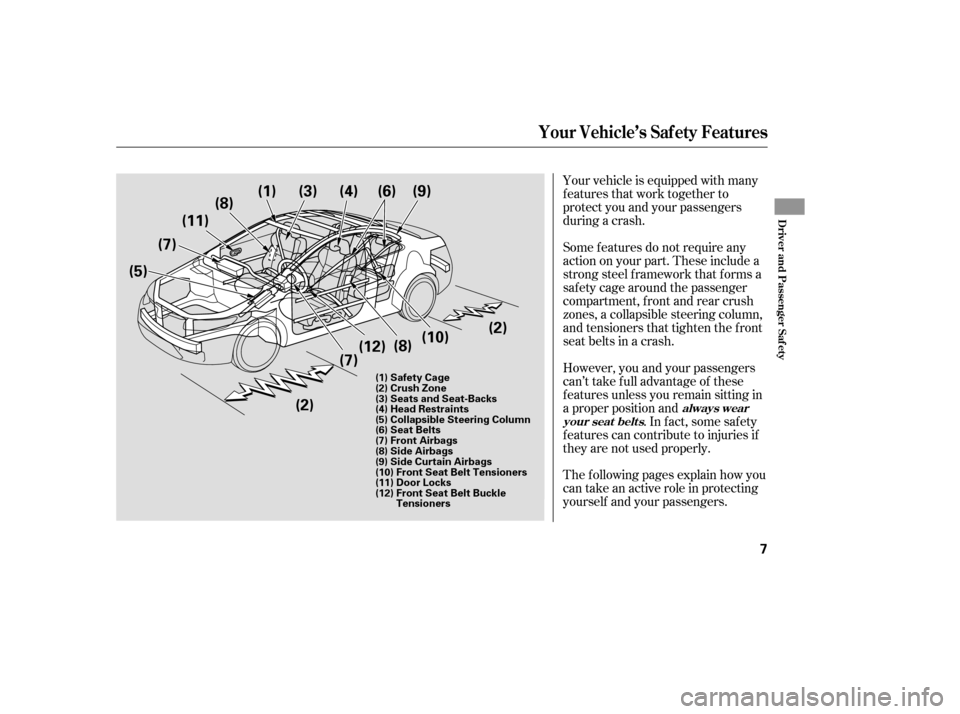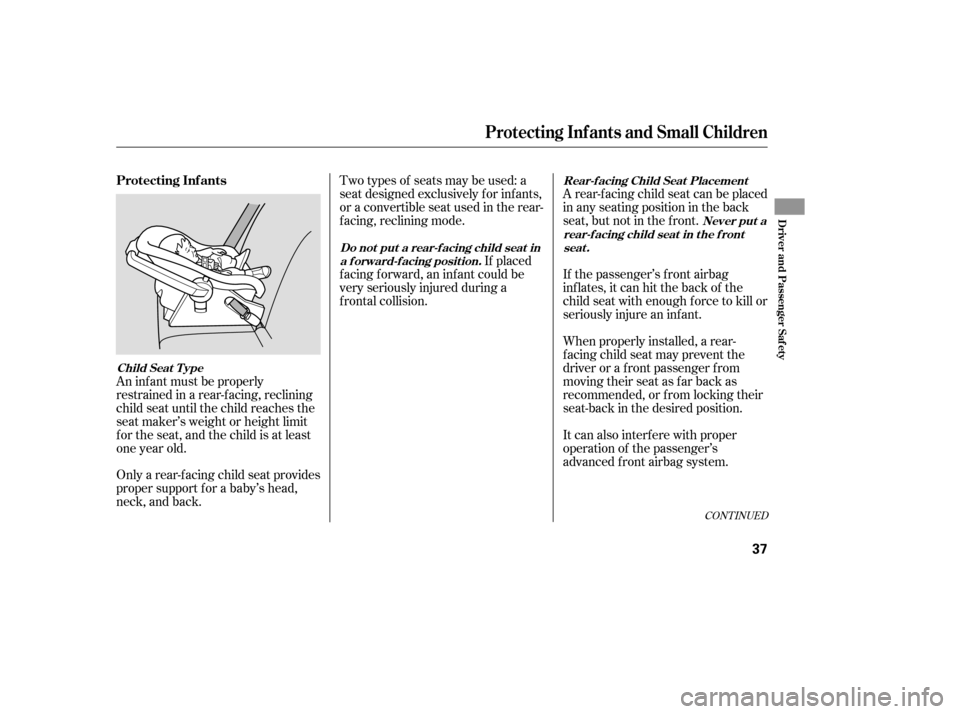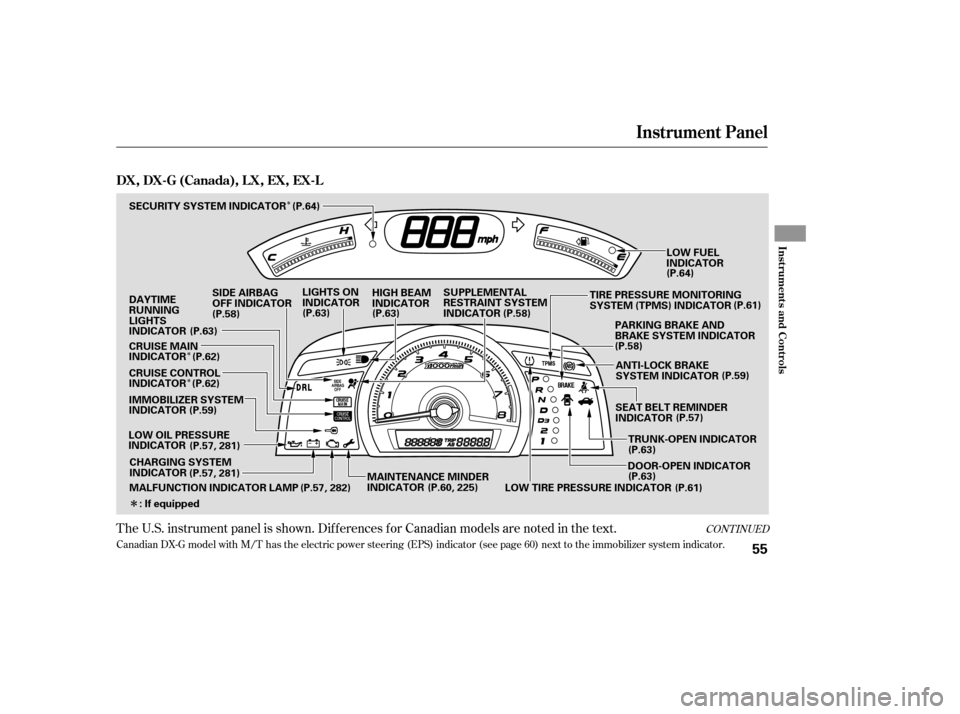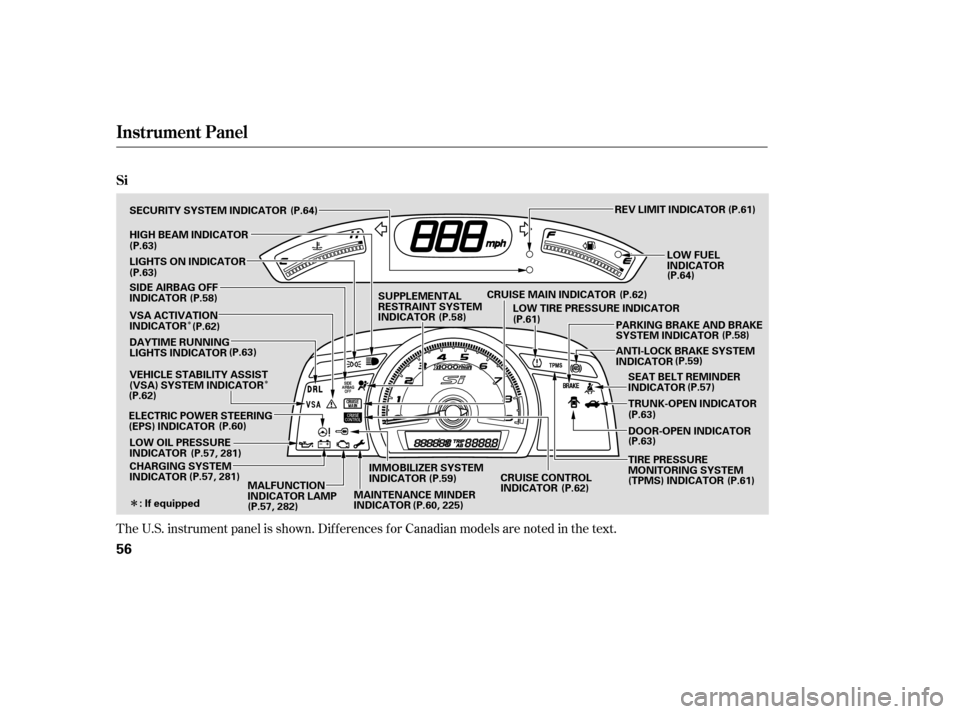Page 7 of 303
�Î
�Î
�Î
�Î �Î
�Î
�Î
�Î
If equipped
:
Your Vehicle at a Glance
Your Vehicle at a Glance
3
HOOD RELEASE
HANDLE
AUTOMATIC TRANSMISSION
MANUAL TRANSMISSION
GAUGES
INSTRUMENT PANEL
INDICATORS
HAZARD WARNING
BUTTON
(P.9, 23)
(P.9, 23)
ACCESSORY POWER
SOCKETS
DRIVER’S FRONT AIRBAG
FUEL FILL DOOR/
TRUNK RELEASE HANDLE PASSENGER’S FRONT
AIRBAG
A/T model is shown. (P.55, 56)
(P.65)
(P.104) (P.80)
(P.100) (P.188) (P.187, 90) (P.108)(P.208)
(P.205)(P.114)
(P.119)
(P.74)
MIRROR CONTROLS
POWER DOOR LOCK
MASTER SWITCH
POWER WINDOW
SWITCHES HEATING/COOLING
CONTROLS
AUDIO SYSTEM
CLOCK
MOONROOF SWITCH (P.102)
(P.180)
�����—�����—�
�
�y�
�������������y���
�(�+���������y���������y
Page 10 of 303

Your vehicle is equipped with many
features that work together to
protect you and your passengers
during a crash.
However, you and your passengers
can’t take f ull advantage of these
f eatures unless you remain sitting in
a proper position and. In fact, some safety
f eatures can contribute to injuries if
they are not used properly.
The f ollowing pages explain how you
cantakeanactiveroleinprotecting
yourself and your passengers.
Some f eatures do not require any
action on your part. These include a
strong steel f ramework that f orms a
saf ety cage around the passenger
compartment, front and rear crush
zones, a collapsible steering column,
and tensioners that tighten the f ront
seat belts in a crash.
Your Vehicle’s Saf ety Features
always wear
your seat belt s
Driver and Passenger Saf ety
7
(7) (2)
(6)
(4)
(7)
(5)
(2)
(11)
(9)
(10)
(12)
(8)
(1) (3)
(8)
(1) Safety Cage
(2) Crush Zone
(3) Seats and Seat-Backs
(4) Head Restraints
(5) Collapsible Steering Column
(6) Seat Belts
(7) Front Airbags
(8) Side Airbags
(9) Side Curtain Airbags
(10) Front Seat Belt Tensioners
(11) Door Locks
(12) Front Seat Belt Buckle Tensioners
�����—�����—�
�
�y�
�������������y���
�(�+���������y�����
���y
Page 14 of 303

If you sit too close to the steering
wheel or dashboard, you can be
seriously injured by an inf lating f ront
airbag, or by striking the steering
wheel or dashboard.Once your seat is adjusted correctly,
rock it back and f orth to make sure
the seat is locked in position.
See page f or how to adjust the
f ront seats.Adjust the driver’s seat-back to a
comf ortable, upright position,
leaving ample space between your
chest and the airbag cover in the
center of the steering wheel.
Passengers with adjustable seat-
backs should also adjust their seat-
back to a comf ortable, upright
position.
If you cannot get f ar enough away
f rom the steering wheel and still
reach the controls, we recommend
that you investigate whether some
type of adaptive equipment may help.
The National Highway Traffic Safety
Administration and Transport
Canada recommend that drivers
allow at least 10 inches (25 cm)
between the center of the steering
wheel and the chest. In addition to
adjusting the seat, you can adjust the
steering wheel up and down, and in
and out (see page ).
75
92
Protecting A dults and T eens
Adjust the Seat-Backs
3.
12
Sitting too close to a front
airbag can result in serious
injury or death if the front
airbags inflate.
Always sit as far back from the
front airbags as possible.
�����—�����—�
�
�y�
�������������y���
�(�+���������y�����
���y
Page 38 of 303

�µ
Children who play in vehicles can
accidentally get trapped inside.
Teach your children not to play in
or around vehicles. Know how to
operate the emergency trunk
opener and decide if your children
should be shown how to use this
feature(seepage ).Even very young
children learn how to unlock
vehicle doors, turn on the ignition
switch, and open the trunk, which
can lead to accidental injury or
death.
For example, infants and small
childrenleftinavehicleonahot
day can die f rom heatstroke. A
child lef t alone with the key in the
ignition switch can accidentally set
the vehicle in motion, possibly
injuring themselves or others. Leaving children without
adult supervision is illegal in most
states and Canadian provinces,
and can be very hazardous. If a child wraps a loose
seat belt around their neck, they
can be seriously or f atally injured.
(See pages and f or how to
activate and deactivate the
lockable retractor.) 43 44
91
Protecting Children General Guidelines
Lock both doors and the trunkwhen your vehicle is not in use.
K eep vehicle keys/remot etransmitters out of the reach ofchildren.
Do not leave children alone in a
vehicle.
Make sure any unused seat belt
t hat a child can reach is buckled,the lockable retractor is activated,
and the belt is f ully retracted and locked.
36
�����—�����—�
�
�y�
����
����
���y���
�(�+���������y�������
�y
Page 39 of 303

An inf ant must be properly
restrained in a rear-f acing, reclining
child seat until the child reaches the
seat maker’s weight or height limit
f or the seat, and the child is at least
one year old.
Only a rear-f acing child seat provides
proper support f or a baby’s head,
neck, and back.Two types of seats may be used: a
seat designed exclusively f or inf ants,
or a convertible seat used in the rear-
f acing, reclining mode.
If placed
f acing f orward, an inf ant could be
very seriously injured during a
f rontal collision. A rear-f acing child seat can be placed
in any seating position in the back
seat, but not in the f ront.
If the passenger’s f ront airbag
inflates, it can hit the back of the
child seat with enough f orce to kill or
seriously injure an inf ant.
When properly installed, a rear-
f acing child seat may prevent the
driver or a f ront passenger f rom
moving their seat as far back as
recommended, or f rom locking their
seat-back in the desired position.
It can also interf ere with proper
operation of the passenger’s
advanced front airbag system.
CONT INUED
Protecting Inf ants
Child Seat T ypeDo not put a rear-f acing child seat in
a f orward-f acing position. Rear-f acing Child Seat Placement
Never put a
rear-f acing child seat in t he f ront seat .
Protecting Inf ants and Small Children
Driver and Passenger Saf ety
37
�����—�����—�
�
�y�
����
����
���y���
�(�+���������y���������y
Page 53 of 303
�Î
�Î
�Î
�Î
�Î �Î�Î
�Î
If equipped
:
Control L ocations
54
A/T model is shown. INSTRUMENT PANEL
INDICATORS
ACCESSORY POWER SOCKETS
HOOD RELEASE
HANDLE FUEL FILL DOOR/
TRUNK RELEASE HANDLE
HAZARD WARNING BUTTON
GAUGES
(P.55, 56)
(P.65)
(P.104)
(P.80)
(P.100) (P.188) (P.187, 90) (P.108)
(P.74) (P.114)
(P.119)
(P.180)
MOONROOF SWITCH
MIRROR CONTROLS
POWER DOOR LOCK
MASTER SWITCH
POWER WINDOW
SWITCHES HEATING/COOLING
CONTROLS
AUDIO SYSTEM
CLOCK
(P.102)
�����—�����—�
�
�y�
����
��������y���
�(�+���������y���������y
Page 54 of 303

�Î
�Î
�Î
�Î
CONT INUED
Canadian DX-G model with M/T has the electric power steering (EPS) indicator (see page 60 ) next to the immobilizer system indicator.
The U.S. instrument panel is shown. Dif f erences f or Canadian models are noted in the text.
Instrument Panel
Inst rument s and Cont rols
DX,DX-G(Canada),LX,EX,EX-L
55
IMMOBILIZER SYSTEM
INDICATOR
LOW OIL PRESSURE
INDICATOR DAYTIMERUNNING
LIGHTS
INDICATOR
LOW FUEL
INDICATOR
SUPPLEMENTAL
RESTRAINT SYSTEM
INDICATOR
SEAT BELT REMINDER
INDICATORANTI-LOCK BRAKE
SYSTEM INDICATOR
LIGHTS ON
INDICATOR
HIGH BEAM
INDICATOR
SECURITY SYSTEM INDICATOR
SIDE AIRBAG
OFF INDICATOR
(P.58)
(P.59) (P.63)
(P.57, 281) (P.60, 225)(P.63)
(P.57)
(P.58) (P.64)
(P.58)
(P.63)
PARKING BRAKE AND
BRAKE SYSTEM INDICATOR
(P.59)
MALFUNCTION INDICATOR LAMP (P.57, 282) MAINTENANCE MINDER
INDICATOR TRUNK-OPEN INDICATOR
(P.63)
DOOR-OPEN INDICATOR
CHARGING SYSTEM
INDICATOR
(P.57, 281)
(P.61)
LOW TIRE PRESSURE INDICATOR
: If equipped (P.64)
(P.63) TIRE PRESSURE MONITORING
SYSTEM (TPMS) INDICATOR
(P.61)
CRUISE CONTROL
INDICATOR
CRUISE MAIN
INDICATOR
(P.62)
(P.62)
�����—�
���—�����y�
����
��������y���
�(�+���������y���������y
Page 55 of 303

�Î
�Î�Î
The U.S. instrument panel is shown. Dif f erences f or Canadian models are noted in the text.
Instrument Panel
Si
56
REV LIMIT INDICATOR
DOOR-OPEN INDICATOR
ANTI-LOCK BRAKE SYSTEM
INDICATOR
SEAT BELT REMINDER
INDICATOR
TRUNK-OPEN INDICATOR
CHARGING SYSTEM
INDICATOR
LOW OIL PRESSURE
INDICATOR
ELECTRIC POWER STEERING
(EPS) INDICATOR DAYTIME RUNNING
LIGHTS INDICATOR
SECURITY SYSTEM INDICATOR
LIGHTS ON INDICATOR
SUPPLEMENTAL
RESTRAINT SYSTEM
INDICATOR
HIGH BEAM INDICATOR
: If equipped PARKING BRAKE AND BRAKE
SYSTEM INDICATOR
LOW FUEL
INDICATOR
(P.63)
(P.63)
SIDE AIRBAG OFF
INDICATOR
(P.58)
VSA ACTIVATION
INDICATOR
(P.63)
VEHICLE STABILITY ASSIST
(VSA) SYSTEM INDICATOR
(P.62)
(P.60)
(P.57, 281)
(P.57, 281) (P.64)
(P.61)
(P.64)
CRUISE MAIN INDICATOR LOW TIRE PRESSURE INDICATOR
MALFUNCTION
INDICATOR LAMP IMMOBILIZER SYSTEM
INDICATOR
(P.62)
(P.62)
(P.61) (P.58)
(P.59) (P.57)
(P.63)
(P.63)
(P.57, 282) (P.58)
(P.61)
(P.62)
MAINTENANCE MINDER
INDICATOR (P.60, 225)(P.59)
CRUISE CONTROL
INDICATOR TIRE PRESSURE
MONITORING SYSTEM
(TPMS) INDICATOR
�����—�����—�
�
�y�
����
��������y���
�(�+���������y�������
�y